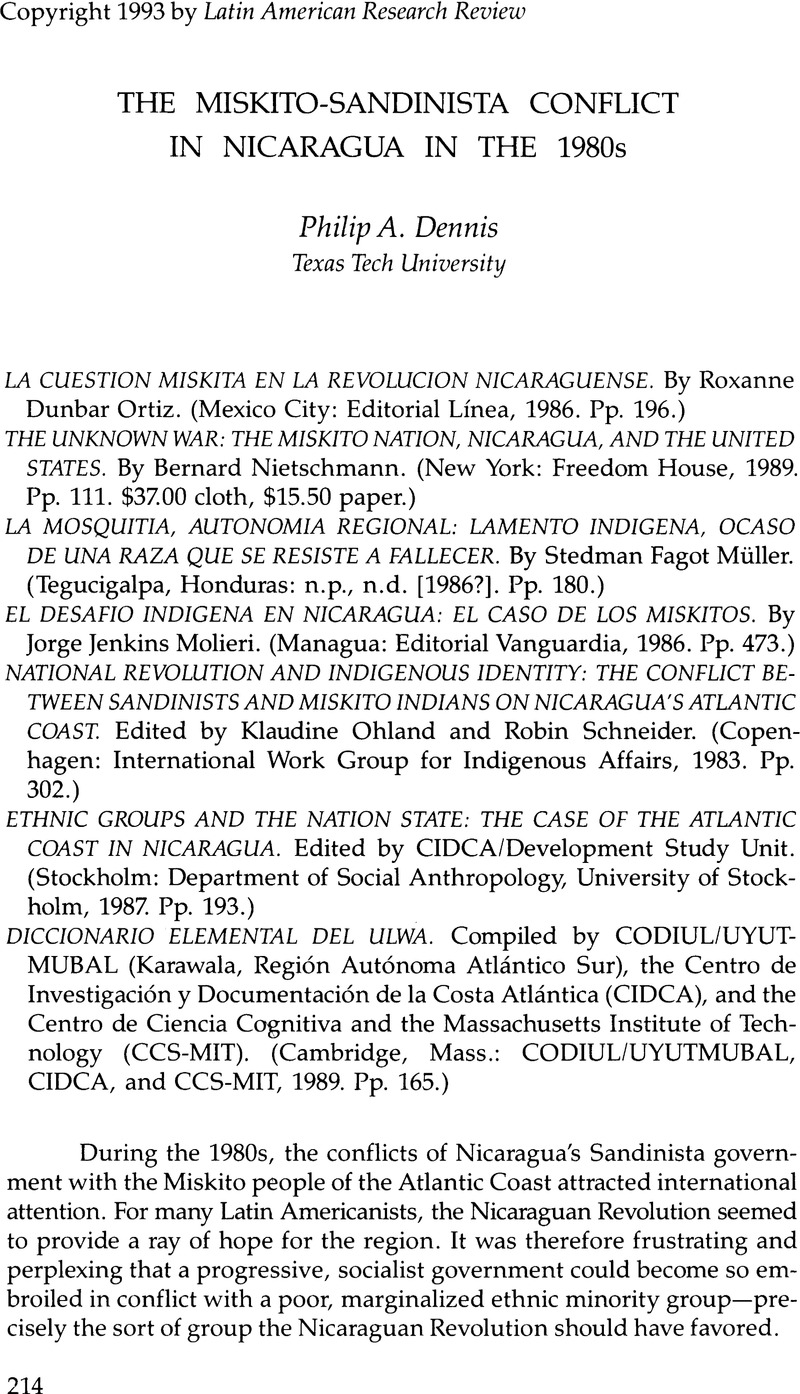Published online by Cambridge University Press: 12 October 2022

1. A rich literature of travel and exploration on the Miskito Coast gives many insights into the region and its peoples. Three of the best examples, spanning the seventeenth century to the present, are M. W., “The Mosqueto Indian and His Golden River,” in A Collection of Voyages and Travels, edited by Awnsham Churchill, 6:285–98 (London: J. Walthoe, 1732); C. Napier Bell, Tangweera: Life and Adventures among Gentle Savages (Austin: University of Texas Press, 1989 [first pub. 1899]); and Bernard Nietschmann, Caribbean Edge: The Coming of Modern Times to Isolated People and Wildlife (Indianapolis, Ind.: Bobbs-Merrill, 1979).
2. Nicaraguan sources currently use the spelling “Miskitu,” reflecting a recent linguistic conclusion that the Miskito language does not really have the vowel “o.” I continue to use the spelling “Miskito” here simply because it is well established in the older literature.
3. Mary W. Helms, Asang: Adaptations to Culture Contact in a Miskito Community (Gainesville: University of Florida Press, 1971), 14–22.
4. Anthropologist Richard N. Adams was present at the organizational meeting of MISURASATA and describes the situation in two articles: “The Sandinistas and the Indians: The ‘Problema’ of the Indians in Nicaragua,” Caribbean Review 10, no. 1 (1981):22–25, 55–56; and “The Dynamics of Societal Diversity: Notes from Nicaragua for a Sociology of Survival,” American Ethnologist 8, no. 1 (1981):1–20.
5. See “The Miskitos in Nicaragua, 1981–1984,” Americas Watch Report (New York: Americas Watch, 1984).
6. One carefully researched account is Peace and Autonomy on the Atlantic Coast of Nicaragua: A Report of the LASA Task Force on Human Rights and Academic Freedom, by Martin Diskin, Thomas Bossert, Salomón Nahmad S., and Stefano Varese (Pittsburgh, Pa.: Latin American Studies Association, 1986). A good journalistic account is Penny Lernoux, “Nicaragua's Miskitos, Part I: Strangers in a Familiar Land,” The Nation, 14 Sept. 1985, pp. 202–6; and “Part II: The Indians and the Comandantes,” The Nation, 28 Sept. 1985, pp. 275–78. For the Sandinista perspective, see Trabil Nani: Historical Background and Current Situation on the Atlantic Coast of Nicaragua (Managua: Center for Research and Documentation of the Atlantic Coast [CIDCA], n.d.). My early predictions of imminent conflict, based on my field work in 1978–79, turned out to be unfortunately accurate. See Dennis, “The Costeños and the Revolution in Nicaragua,” Journal of Interamerican Studies and World Affairs 23, no. 3 (1981):271–96.
7. Cited in Martin Diskin, “The Manipulation of Indigenous Struggles,” in Reagan versus the Sandinistas: The Undeclared War on Nicaragua, edited by Thomas W. Walker (Boulder, Colo.: Westview, 1987), 80. Diskin's essay summarizes the ways in which the Reagan administration used the Miskito case as anti-Sandinista propaganda.
8. Indians of the Americas: Human Rights and Self-Determination (London: Zed, 1984).
9. Michael D. Olien, “The Miskito Kings and the Line of Succession,” Journal of Anthropological Research 39, no. 2 (1983):198–241.
10. Bernard Nietschmann, Between Land and Water: The Subsistence Ecology of the Miskito Indians, Eastern Nicaragua (New York: Seminar, 1973).
11. See “The Third World War,” Cultural Survival Quarterly 11, no. 3 (1987):1–16.
12. Mary W. Helms, “Miskito Slaving and Culture Contact: Ethnicity and Opportunity in an Expanding Population,” Journal of Anthropological Research 39, no. 2 (1983):179–97.
13. David C. Brooks, “U.S. Marines, Miskitos, and the Hunt for Sandino: The Río Coco Patrol in 1928,” Journal of Latin American Studies 21, pt. 2 (1989):311–42.
14. Luis Carrion, “Our Challenge Is to Integrate without Destroying,” in National Revolution and Indigenous Identity, edited by Klaudine Ohland and Robin Schneider (Copenhagen: International Work Group for Indigenous Affairs, 1983), 202.
15. A more recent book of documents provides very useful information on the late nineteenth and early twentieth centuries. See The Nicaraguan Mosquitia in Historical Documents, 1844–1927: The Dynamics of Ethnic and Regional History, edited by Eleonore von Oertzen and Lioba Rossbach (Berlin: Dietrich Reimer Verlag, 1990).
16. Barrett's dissertation at the University of Wisconsin, “The Syringe and the Rooster Dance: Medical Anthropology in Southeastern Nicaragua” (1991 draft), will soon be published.
17. See three articles by Michael D. Olien: “Micro/Macro-Level Linkages: Regional Political Structures on the Mosquito Coast, 1845–1864,” Ethnohistory 34, no. 3 (1987):256–87; “Imperialism, Ethnogenesis, and Marginality: Ethnicity and Politics on the Mosquito Coast, 1845–1964,” Journal of Ethnic Studies 16, no. 1 (1988):1–29; and “Were the Miskito Indians Black? Ethnicity, Politics, and Plagiarism in the Mid-Nineteenth Century,“ Nieuwe West-Indische Gids (Dordrecht, the Netherlands), nos. 1–2 (1989):27–50.
18. Hale's dissertation will soon be published by Stanford University Press as Contradictory Consciousness: Miskitu Indians, the Nicaraguan State, and the Struggles for Autonomy, 1880–1987. It should be a major contribution on the topic.
19. “La conciencia política miskita: hacia un análisis coyuntural,” Wani (Managua) 8 (1990):80–93.
20. “Wan Tasbaya Dukiara: nociones contenciosas de los derechos sobre la Tierra en la Historia Miskita,” Wani 12 (1992): 1–19.
21. Carlos M. Vilas, State, Class, and Ethnicity in Nicaragua: Capitalist Modernization and Revolutionary Change on the Atlantic Coast (Boulder, Colo.: Lynne Rienner, 1989), 33–36, 86–89, 99, 116, 145.
22. The Black population of Limón province in Costa Rica, to the south, has occupied a similar position. See Philippe Bourgois, “Blacks in Costa Rica: Upward Mobility and Ethnic Discrimination,” in Costa Rica Reader, edited by Marc Edelman and Joanne Kenen (New York: Grove Weidenfelf, 1989), 161–69.
23. Philip A. Dennis and Michael D. Olien, “Kingship among the Miskito,” American Ethnologist 11, no. 4 (1984):718–37. See also Mary W. Helms's rebuttal, “Of Kings and Contexts: Ethnohistorical Interpretations of Miskito Political Structure and Function,” American Ethnologist 13, no. 3 (1986):506–23.
24. See Salomón Nahmad Sitton, “Oaxaca y el CIESAS: una experiencia hacia una nueva antropología,” América Indígena 50, nos. 2–3 (1990):11–32; and Russell Bernard, “Preserving Language Diversity,” Human Organization 51, no. 1 (1992):82–89.
25. Orin Starn, “New Literature on Peru's Sendero Luminoso,” LARR 27, no. 2 (1992):212–26.